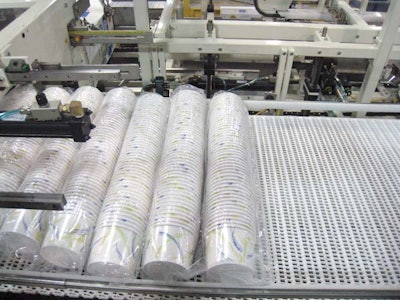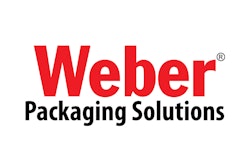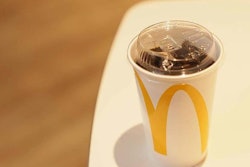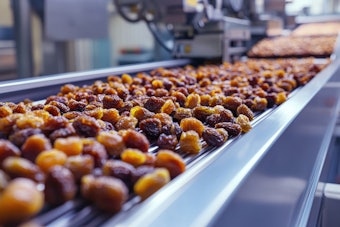Finland-based packaging provider Huhtamäki Oyj provides some of the world’s most recognizable consumer goods packaging and foodservice containers. The company’s U.S. division, Huhtamaki-America, is headquartered in De Soto, KS, and operates 18 facilities in North and South America. In late 2007, an equipment purchase by Huhtamaki-America’s corporate engineering group for one of the division’s largest plants, in Fulton, NY, sent the manufacturing facility scrambling for solutions to automate the packaging of its sleeved foodservice cups and lids in record time.
The purchase consisted of two new PMC 1002 cup-forming machines from Paper Machinery Corp. (www.papermc.com). With a top-rated speed of 330 cups/min, the model was selected to more than double the Fulton plant’s foodservice cup-production rate. But the project posed many challenges for the plant team: They had to meet ever more-stringent safety standards; double their production speeds; operate within a limited floor space; improve efficiency; and reduce scrap and costs. To meet these objectives, the team decided that the entire packaging process, including the case packing of sleeved cups and lids, and palletizing, both of which until then had been manual, needed to move to “smart” automation.
Defining smart automation, Dan Carman, Huhtamaki-America manager of engineering and maintenance services for the Fulton plant, says, “Some companies feel compelled to add automation just for the sake of saying that they automated a process. We wanted to bring in technology that matched our internal strengths with our external threats and opportunities. In other words, we wanted to be able to build for the future.”
The goal of the automation project was to have the packaging and palletizing lines run flawlessly, two shifts per day, seven days a week, Carman explains. The line would have to run two different-sized foodservice paperboard cups with eight different carton sizes and cup/lid combinations, on two adjacent case-packing lines.
Three vendors were approached for the automation project. A detailed project scope, vendor selection, and request for capital funds were necessary prior to Q3 in 2007. Both of the new high-speed cup-forming machines were due for delivery in January 2008, while full installation and production were scheduled for Q2 2008. “Since these were the first two cup-forming models bought by Huhtamaki-Americas, we decided to receive, install, train, and start up each one separately, and then install the automation afterward,” Carman relates.
Case-packing combo packs is new
The vendor selected to automate case packing and palletizing was Schneider Packaging Equipment (www.schneiderequip.com). Says Carmen, “Schneider was willing to share actual layout and scope plans, not just generic layouts, with a real quote. This was the first major automation project for Huhtamaki-America, and we needed a company that could work closely with us.
“We wanted a ‘lean’ layout, but one that promoted easier access for both the operators and the maintenance personnel. Schneider was the only vendor that proposed a robotic palletizing cell in addition to automating the case-packing line, and yet the other vendors’ plans required more floor space.”
The new packaging line handles the output from the two new cup-forming machines, as well as lids created and sleeved on a separate line and moved manually to the case-packing station. One of the cup-forming machines, designated the NS25 in the Fulton plant, produces 8-oz cups; the second, the NS26, produces 12-oz sizes. Once formed, cups are conveyed in separate lanes to a new dual-jaw vertical bagger from Rennco (www.rennco.com). Explains Carman, “The Rennco bagger is actually two separate baggers in one machine. Cups are pneumatically transported from the PMC 1002 machines and are sleeved independently. Each PMC machine has its own ‘lane,’ so you can never mix up cups from either production line.”
Once bagged in film sleeves, the cups make their way via Hytrol (www.hytrol.com) conveyors to the case-packing area, where two model HCP-10 horizontal case packers from Schneider (designated the CP25 and CP26) pack either cups only (bulk packs) or cups and lids (combo packs) in eight configurations. Each case packer typically produces from one to three different products each day.
“One of the things we are currently doing with this system is stacking cups and lids in the same box, but stacked separately. This has never been done using automation before,” says Carman. “We have a customer who insists on this preference, but it was incredibly labor-intensive for us before, and we thought there was no way we could automate this process affordably. We went to Schneider with the request, and they took on the challenge; now it’s ready to run.”
During the case-packing of combo packs, the HCP-10 counts, indexes, and horizontally accumulates the prescribed number of sleeved cups, and then it sets a sleeve of lids, coming from the opposite direction, on top of the cups. The entire group of sleeved cups and lids is then pushed into the waiting case. The cases are then sealed with tape and are carried by roller conveyors to a Schneider-designed robotic palletizing cell.
Palletizer performs many functions
In the caged “Robox” area, one robot palletizes the output from both case packers. The Fanuc (www.fanucrobotics.com) model M410iB four-axis robot typically packs between four and eight different pallet configurations, based on case size and customer scheduling. The robot also facilitates the application of dual labels and spot glue for pallet stability.
When a case enters the palletizing cell from either the CS25 or CS26 case-packing line, the robot picks up the case and moves it to one of two model 5300 printer/applicators from Weber Marking Systems (www.webermarking.com). When given the proper signal from the robot, the Weber 5300 prints a predesigned label and then applies it to one side of the case, while the robot holds the case. The robot then rotates the case, and a second label is printed and applied to an adjacent side of the case. During this process, the printer/applicator extends a cylinder, applies the label via a tamp-and-blow method, and then retracts the cylinder to get the next label.
“Labeling was improved with the new system,” says Huhtamaki engineering project designer Terry Lucas. “Other systems use labels that come off of an adhesive spool. There is a lot of downtime, and it’s very expensive. On the new Schneider system, we have incorporated two separate label printer/applicators.” The result is that labels are automatically and accurately applied in the palletizing cell.
As for the spot-glue application function, during Schneider’s initial on-site evaluation visit, the supplier noticed that Huhtamaki was taping its pallet loads to stabilize them for forklift transport to the stretch wrapper. Schneider suggested adding an optional glue step to the palletizing process. Now, after label application, the robot indexes the carton over the top of a Nordson (www.nordson.com) hot-melt glue nozzle, which sprays a light bead of low-tack glue onto the bottom of the case. This keeps the case from slipping once it is placed on the pallet and transported. When a pallet load has been completed, it automatically exits the robot cell, and an empty pallet enters.
A template for future growth
The entire project took approximately nine to 10 months, Carman says. “But that is short when you are exposing an entire plant organization to that much change,” he adds. The cup-forming machines were commissioned in February 2008, and the Schneider equipment was installed two months later.
“Schneider helped us grow in confidence,” Carman says. “We got more runtime on the equipment, and more people beyond the core team were trained. Prior to shipment and installation of the packaging cell, the entire system was thoroughly tested at Schneider’s facility in Fulton. They were close enough that we could ship our product samples to them and observe commissioning the same day. We were able to bring operators, electricians, mechanics, supervisors, and managers over to Schneider’s facility to participate, train, and even make minor changes that would facilitate a faster learning curve at the Fulton plant.”
Carman adds that because the Schneider machines are so well made, the Fulton plant was able to simply incorporate the supplier’s recommendations into its maintenance plan. Equipment downtime is rare, he relates, but changeover processes are still evolving due to the inconsistent quality of some of the materials that support the automation equipment. “We found that when we switched from a manual to an automatic process, the quality of the ancillary materials had to evolve to a higher, more-consistent quality as well. We have been working with our other partners on these fronts,” he says.
“Overall we are extremely satisfied,” Carman concludes. “This is a major milestone for the Huhtamaki organization. Since this was the first-of-its-kind automation project for Huhtamaki, we obviously could have done some things better, on both sides. However, we did a great job of project-scope development and charting, and follow-up documentation. We now have the template to plan and implement future automation projects, not just at Fulton, but also at any of our other Huhtamaki-America locations.”






























